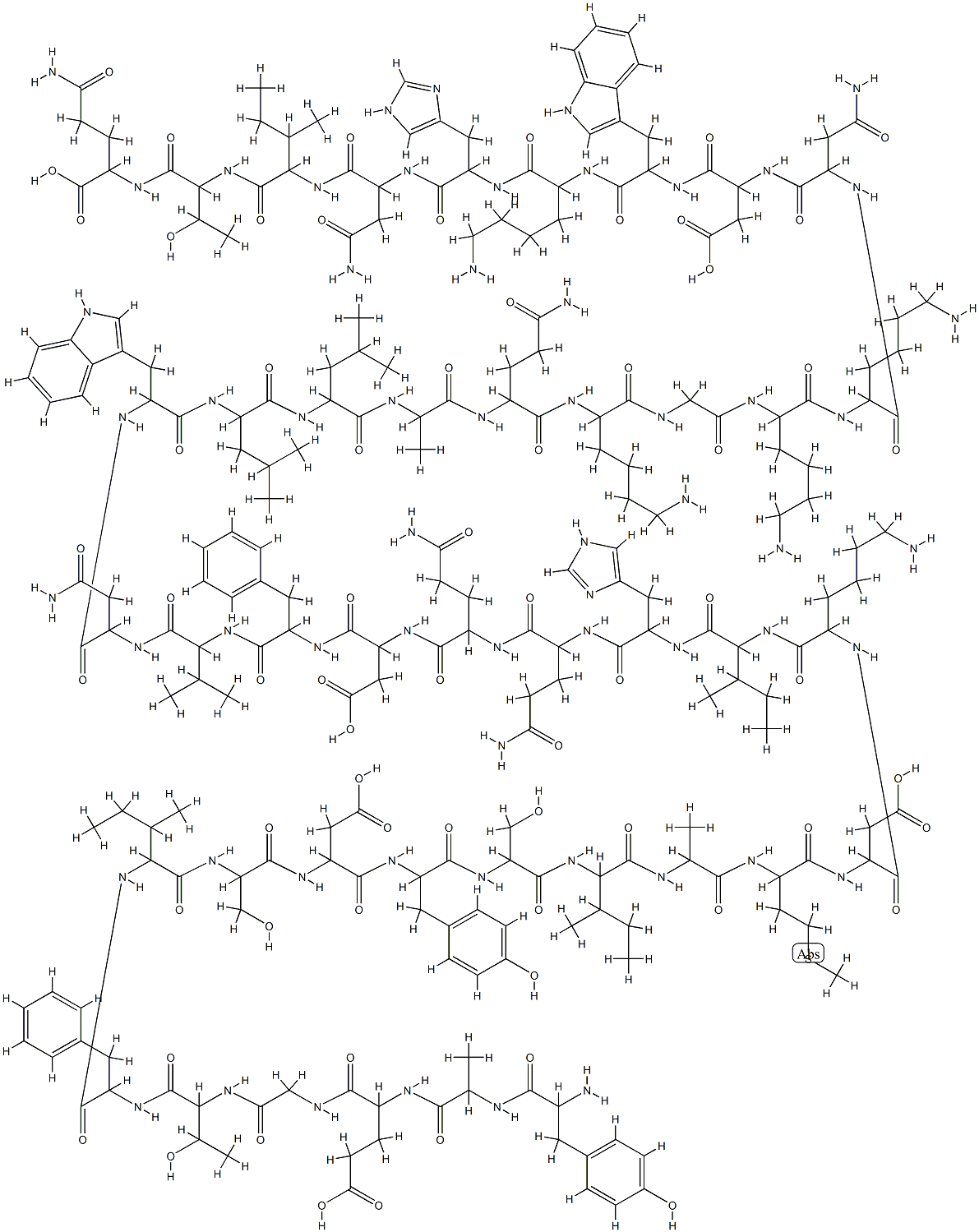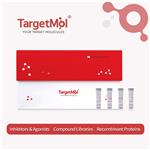
GIP (HUMAN)
- Product NameGIP (HUMAN)
- CAS100040-31-1
- CBNumberCB3381115
- MFC226H338N60O66S
- MW4983.52932
- MDL NumberMFCD00081634
- MOL File100040-31-1.mol
Chemical Properties
| storage temp. | −20°C |
| form | Solid |
| color | White to off-white |
| Water Solubility | Soluble to 1 mg/ml in water |
| Sequence | H-Tyr-Ala-Glu-Gly-Thr-Phe-Ile-Ser-Asp-Tyr-Ser-Ile-Ala-Met-Asp-Lys-Ile-His-Gln-Gln-Asp-Phe-Val-Asn-Trp-Leu-Leu-Ala-Gln-Lys-Gly-Lys-Lys-Asn-Asp-Trp-Lys-His-Asn-Ile-Thr-Gln-OH |
| FDA UNII | 1O4H75S7H2 |
GIP (HUMAN) Price
| Product number | Packaging | Price | Product description | Buy |
|---|---|---|---|---|
| Sigma-Aldrich G2269 | 0.1mg | $404 | Gastric Inhibitory Polypeptide human ≥95% (HPLC) |
Buy |
| Sigma-Aldrich G2269 | 0.5mg | $1620 | Gastric Inhibitory Polypeptide human ≥95% (HPLC) |
Buy |
| Sigma-Aldrich G2269 | .1mg | $358 | Gastric Inhibitory Polypeptide human ≥95% (HPLC) |
Buy |
| Sigma-Aldrich G2269 | .5mg | $1440 | Gastric Inhibitory Polypeptide human ≥95% (HPLC) |
Buy |
| Alfa Aesar J66667 | 0.5mg | $135 | Gastric Inhibitory Peptide, human |
Buy |
GIP (HUMAN) Chemical Properties,Usage,Production
Description
GIP was originally isolated as a gastric inhibitory polypeptide. After the discovery of its glucose-dependent insulinotropic activity, known as the incretin effect, GIP was renamed glucose-dependent insulinotropic peptide.Gastric inhibitory peptide
Abbreviation: GIP
Additional names: gastric inhibitory polypeptide,gastrointestinal inhibitory peptide, glucose-dependent, insulinotropic peptide
Chemical Properties
Human GIP: Mr 4983.6, theoretical pI 6.92. GIP is soluble in water, but insoluble in ethanol. GIP is inactivated by DPP-4.History
GIP was originally isolated from the porcine intestinal extract on the basis of its acid inhibitory activity in dogs (gastric inhibitory polypeptide) in the early 1970s, and subsequently renamed glucose-dependent insulinotropic peptide after the finding of its physiologically important role as a potentiator of glucose-stimulated insulin secretion.Uses
GIP possessing incretin activity enhances glucosestimulated insulin release. GIP agonists are potentially useful for the treatment of diabetes. Moreover, DPP-4 inhibitors are approved for use in diabetes patients because GIP is rapidly deactivated by DPP-4.Biosynthesis
The expression of GIP is regulated by nutrients. The administration of glucose and lipid into the rat gastrointestinal tract increases GIP mRNA levels. Circulating GIP levels are low in the fasted state and increase within minutes of food ingestion. The postprandial levels of circulating GIP are dependent on meal size. The degree to which nutrients regulate GIP secretion is speciesdependent. Fat is a more potent stimulator than carbohydrates in humans, whereas in the rodent and pig, carbohydrates are more potent than fat. Once released, GIP is rapidly deactivated by DPP-4.Receptors
Structure and subtypeThe receptor of GIP is a seven-transmembrane GPCR that belongs to a subclass of the family B. Both the relatively long extracellular N-terminal domain and the first transmembrane domain are important for ligand binding and receptor activation. The C-terminal cytoplasmic domain of the receptor is important for receptor desensitization and internalization. Like their peptide ligands, the GIP receptor and the GLP-1 receptor exhibit high degrees of amino acid sequence identity, with similar molecular structures and signaling processes. However, GIP does not bind to the GLP-1 receptor and vice versa.
Signal transduction pathway
Ligand binding to the GIP receptor primarily activates adenylyl cyclase and increases intracellular cAMP.6 The activation of the MAP kinase pathway, the phospholipase A2 pathway, and the phosphatidylinositol 3-kinase/protein kinase B pathway have also been reported.
Agonist
[D-Ala2]-GIP is an agonist. Tirzepatide (LY3298176) is a dual agonist of GIP and GLP-1 receptors.
Antagonists
GIP(6–30), ANTGIP (GIP-(7–30)-NH2) (a truncated GIP peptide antagonist), GIP(3–30)NH2 (a truncated GIP peptide antagonist), and [Pro3]-GIP; Exendin(9–39) amide are antagonists.
storage
Store at -20°CStructure and conformation
Human GIP is a single 42-aa peptide. The structure of vertebrate GIP is well conserved and both the N-terminal and central regions are important for biological activity because truncated forms of GIP, GIP(1–39), and GIP (1–30) show a high degree of biological activity.2 The N-terminal two aa residues are cleaved off by dipeptidyl-peptidase 4 (DPP-4) in the circulation to form GIP(3–42), which has no insulinotropic activity.Preparation Products And Raw materials
GIP (HUMAN) Suppliers
Global(120)Suppliers
| Supplier | Tel | Country | ProdList | Advantage | |
|---|---|---|---|---|---|
| +undefined-27-86652399 +undefined13627115097 |
market02@senwayer.com | China | 942 | 58 | |
| +86-755-89396905 +86-15013857715 |
admin@nexconn.com | China | 10406 | 58 | |
| +1-631-485-4226 | inquiry@bocsci.com | United States | 19552 | 58 | |
| +8619521488211 | info@longyupharma.com | China | 2555 | 58 | |
| 0551-65326643 18156095617 |
info@cellmano.com | China | 995 | 58 | |
| +86-0371-86658258 +8613203830695 |
factory@coreychem.com | China | 29808 | 58 | |
| +1-2135480471 +1-2135480471 |
sales@sarms4muscle.com | China | 10473 | 58 | |
| 0571-88211921 | sales1@gotopbio.com | CHINA | 2609 | 58 | |
| Info@alfa-chemistry.com | United States | 24072 | 58 | ||
| +8618108235634 | Cecilia@youngshechem.com | China | 2345 | 58 |
100040-31-1, GIP (HUMAN)Related Search
- PHENYLSELENOL
- DICHLORO(ETHYLENEDIAMINE)PLATINUM(II)
- 2,4-PENTANEDIONE, SILVER DERIVATIVE
- COBALT(II) ACETYLACETONATE
- Tosylmethyl isocyanide
- Cupric acetylacetonate
- Ethyl isocyanoacetate
- 1,1,3,3-TETRAMETHYLBUTYL ISOCYANIDE
- METHYL ISOCYANOACETATE
- TRIS(2,2,6,6-TETRAMETHYL-3,5-HEPTANEDIONATO)EUROPIUM(III)
1of4
PROMPT×
PROMPT
The What'sApp is temporarily not supported in mainland China
The What'sApp is temporarily not supported in mainland China
Cancel
Determine


